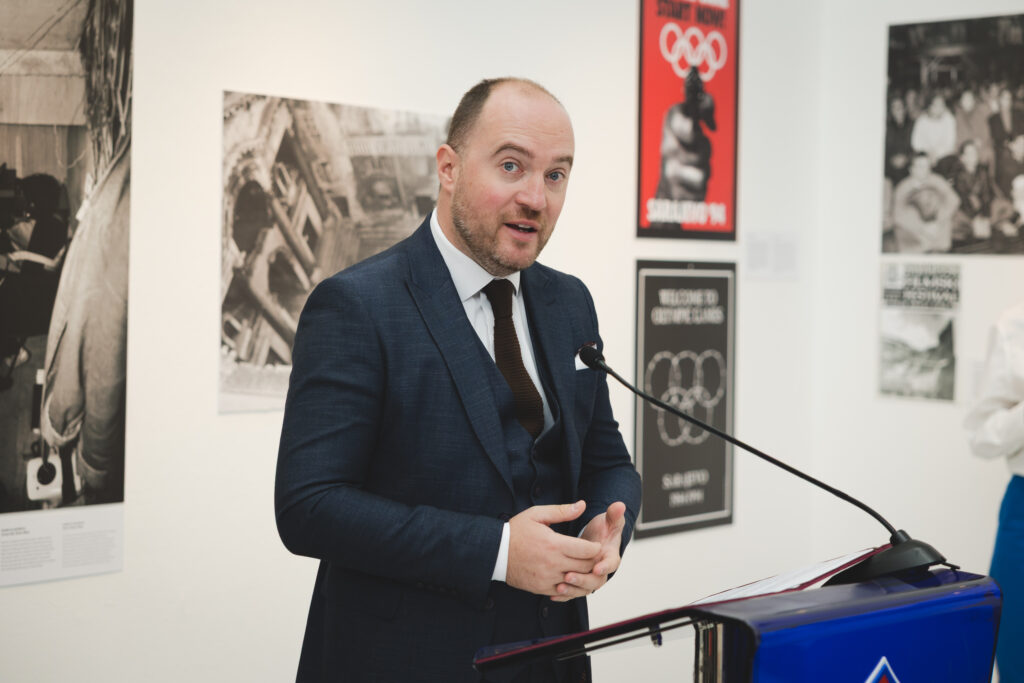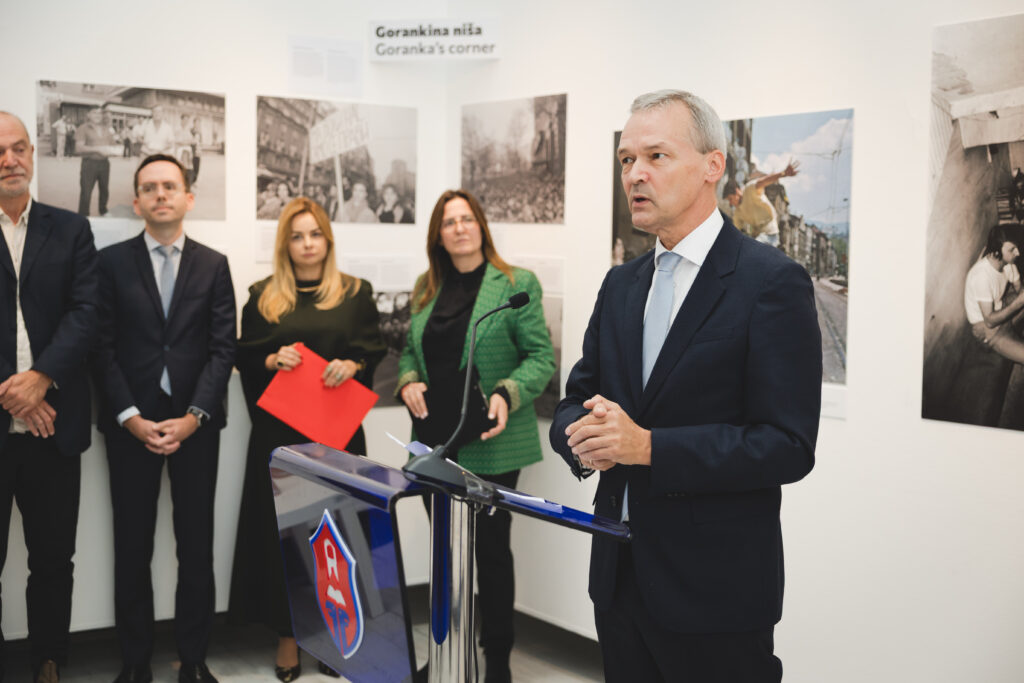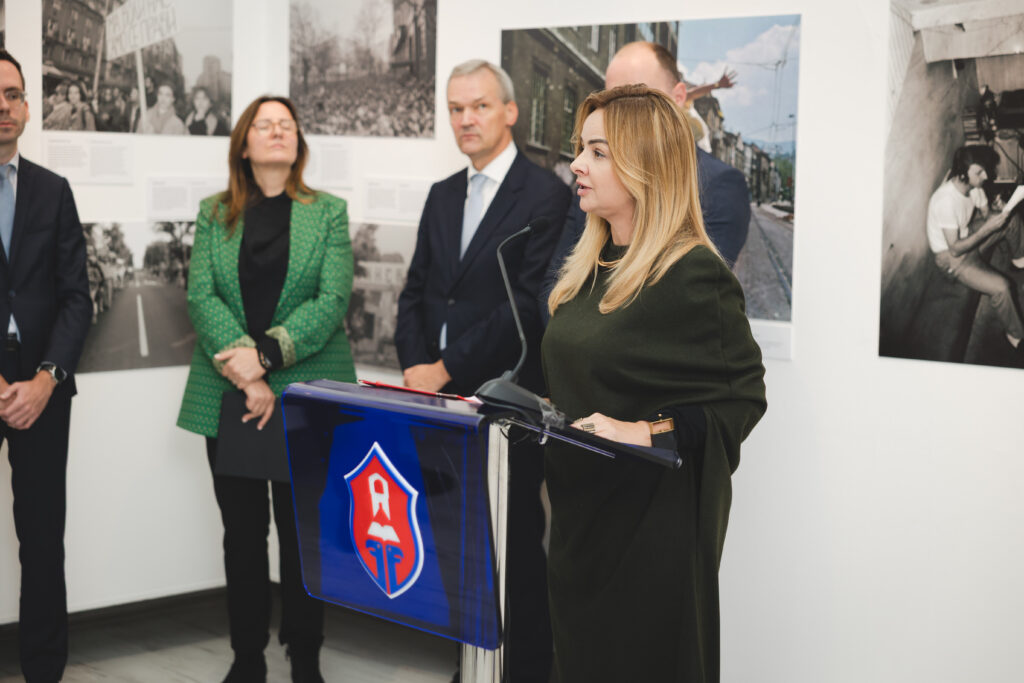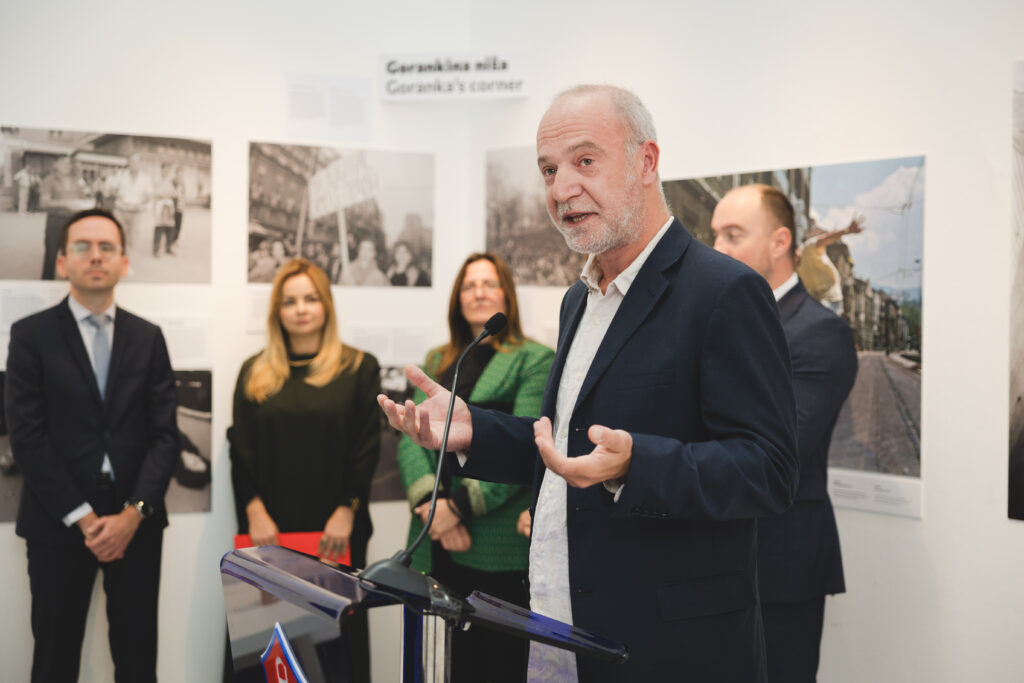Thirty years later, we are witnessing worrying similarities with the 1990s, which is why this exhibition serves both as a reminder of the importance of resisting the regressive ideologies that marked that period, and a warning to reflect for us as a society and not repeat the mistakes of the past, is one of the messages from today’s exhibition opening “The Nineties: From Non-Compliance to Resistance” in Cetinje, organised by the Centre for Civic Education (CCE), the M90 Foundation, and the Cultural Front from Serbia, in cooperation with the Cultural Centre of the Old Royal Capital Cetinje.

“Right here in our city, anti-war protests were organised – the only ones of their kind in Montenegro at that time – which remain recorded as testimony that one can and must choose justice over force, humanity over hatred, and resistance over compliance,”said Mirko Stanić, Vice President of the Assembly of the Old Royal Capital Cetinje, while opening the exhibition. He emphasized that the spirit of resistance did not fade later on, as Cetinje remained a bastion of civic Montenegro, firmly opposing every attempt to undermine its identity. “That legacy continues to bind us today – as Cetinje has never been remained silent in the face of injustice, nor traded its freedom,” Stanić said. “Although we live today in a time different from those years, the struggle for a free and civic Montenegro, unfortunately, still continues. There are still those who wish to take us back into division and hatred, but I am convinced that, precisely because of what these individuals showed in the most difficult years, we will once again know how to choose the path of resistance and freedom and, despite all the challenges, remain standing on the pillars of civic and anti-fascist tradition,” concluded Stanić.

“The exhibition “The Nineties: From Non-Compliance to Resistance” opened in Cetinje, creates space for dialogue about a period that marked our lives and left a deep trace in our shared history,” said Jelena Lela Milošević, Director of the Cultural Centre of the Old Royal Capital Cetinje. “It represents a part of history that serves as a warning” Milošević noted. She strssed that the exhibition is an opportunity to ask ourselves whether we are on the right path and whether we are repeating the mistakes of the past. “Therefore, we thank the organisers for recognising the Cultural Centre of the Old Royal Capital Cetinje as a partner in implementing this important theme. I hope it will remind and warn us all that such periods require a vigilant, conscious society and an adequate democratic response.” Milošević said.
“The legacy of conflict remains present – in communities, in family memories, and in the stories that nations tell about themselves. Confronting that legacy is not easy, but it is essential,” said H.E. Martijn Elgersma, Ambassador of the Kingdom of the Netherlands. He noted that every nation has parts of its history that is not comfortable to look at and warned of today’s threats to peace – nationalism and populism. “That is why the Museum of the Nineties exhibition is such an important and courageous initiative. This exhibition does not confine us to a single narrative but opens space for dialogue, understanding, and empathy. In doing so, it becomes more than a testimony to the past – it becomes a tool for building a more honest and humane future,”concluded Ambassador Elgersma.

“The nineties were a decade that profoundly transformed the region and whose legacy continues to shape our reality today. This exhibition is special because it does not offer simple answers but provides space for understanding and dialogue,” said Bertrand Baucher, Deputy Ambassador of the Republic of France, underlining the importance of the exhibition for reflecting on the past.“France is proud to support this exhibition, and I would like once again to express our sincere gratitude to all those who made it possible. I hope this exhibition will deepen our shared reflection and encourage dialogue and connection,” Baucher stated.
“I am pleased that here in Cetinje – a city of a free spirit and civic defiance – we are opening an exhibition that takes us back to one of the darkest yet most instructive chapters of our recent history. The anti-war energy of Cetinje was one of the beacons of reason amid the madness that engulfed the region,” said Daliborka Uljarević, Executive Director of the Centre for Civic Education (CCE), emphasizing that this also obliges us to address current challenges, particularly revisionism. “History is not made only by those who ruled, but also by those who resisted – the media that exposed propaganda, the artistic resistance through image and word, the activists who defended dignity, and all those citizens who chose peace over hatred,” Uljarević noted. “Time passes, but values remain. This exhibition is also a tribute to all those who, regardless of the cost, choose to remain human, preserving integrity and freedom through resistance. That is why its natural home is Cetinje,” concluded Uljarević.

“My first time in Cetinje, and I am happy that the reason is this anti-war exhibition. There is a photograph from a large demonstration, held not far from this very place, where the message read: “From Lovćen the fairy cries – forgive us, Dubrovnik.” So, in a way, the circle closes, but I believe some will experience this exhibition as a return and a remembrance,” said Dejan Ubović, Director of the M90 Foundation and one of the authors of the exhibition “The Labyrinth of the Nineties.” He expressed hope that young people from Cetinje would visit the exhibition in the coming weeks and learn about the stories of those who, in the hardest of times, had the courage to think and act differently. “It is important for the new generation to see that, during the siege, there were those who fought – through the media, through art, or through personal courage, like Toma Buzov. Such examples show that resistance and humanity have a face and a name,” Ubović added.

The exhibition will be open in Cetinje, at the Gallery of the Cultural Centre of the Old Royal Capital, until 25 October 2025, on weekdays from 9:00 to 19:00 and on Saturdays from 9:00 to 17:00.
This exhibition stems from the initiative “Museum of the Nineties”, which has already been presented in Belgrade, Sarajevo, Podgorica, and Budva, and in June 2025, the permanent installation “Labyrinth of the Nineties” was opened in Belgrade. The exhibition is organised by Cultural Front, Foundation M90, and CCE, with the support of the Ministry of Foreign Affairs of the Kingdom of the Netherlands through the MATRA programme, as well as the European Fund for the Balkans (EFB) and the Shared Horizons project, funded by the Republic of France and implemented by Expertise France / Groupe AFD. The content of this exhibition is the sole responsibility of the authors and does not necessarily reflect the views of the donors.
Maja Marinović, Programme Associate
